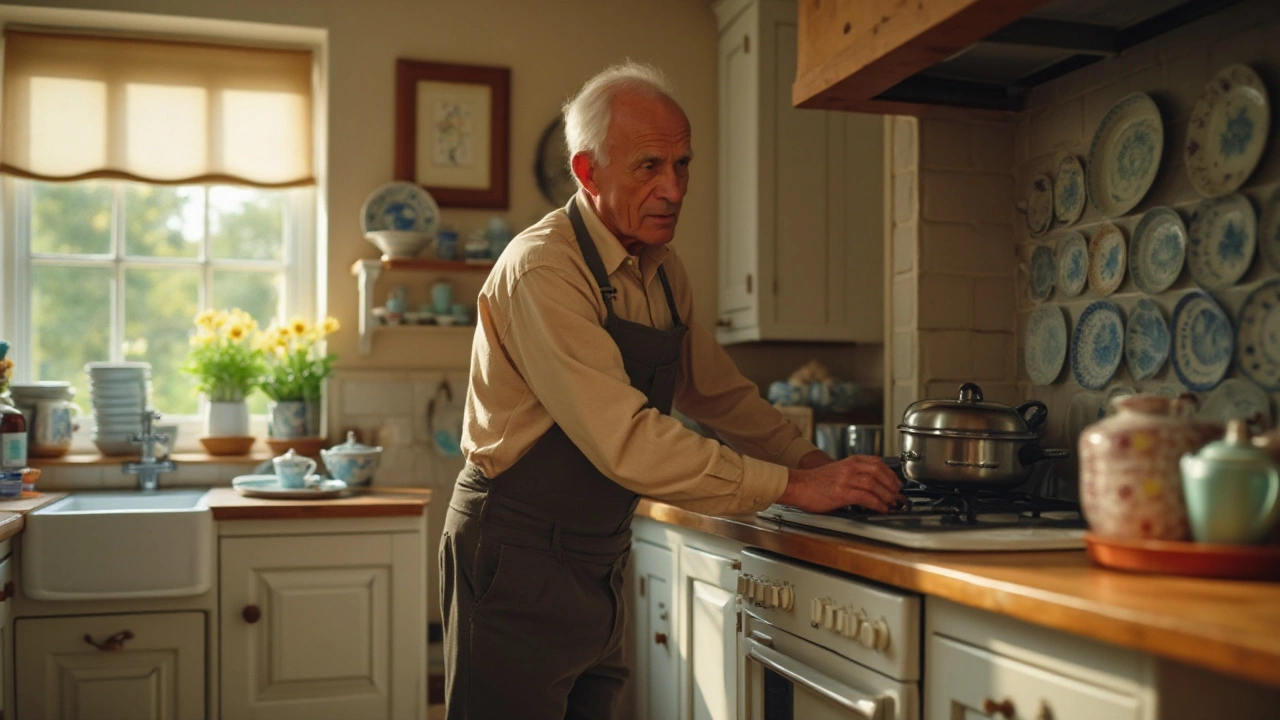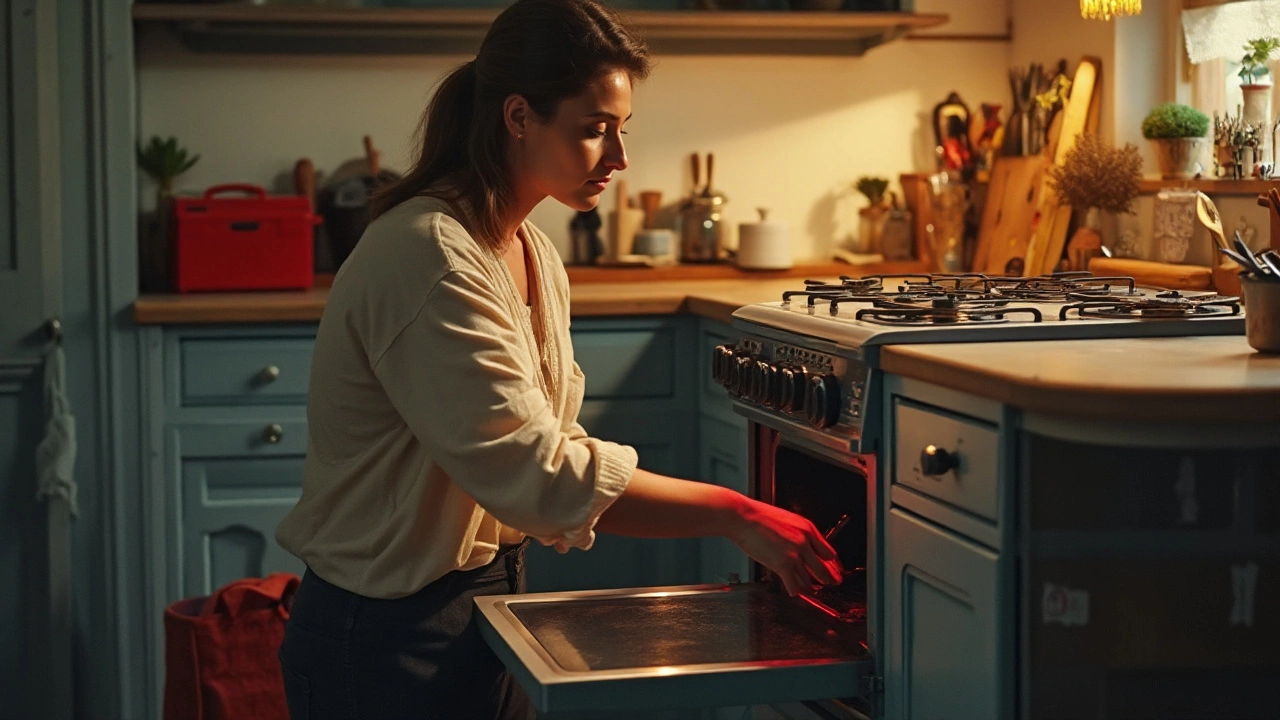Isn't it frustrating when your electric oven suddenly decides to quit on you? The kitchen can feel like it's missing its heartbeat when this essential appliance stops working. But don't worry, many common issues are fixable without the need to rush to a professional or replace the entire unit.
In this guide, we're delving into some of the most frequent reasons your electric oven might not be functioning as expected. We'll walk you through easy-to-follow troubleshooting tips and help you understand when it might be time to get some expert help. By the end of this read, you'll be armed with the knowledge needed to get your oven back to working order or know your next steps. Let's bring that kitchen back to life!
- Understanding Electrical Basics
- Common Problems with Electric Ovens
- DIY Troubleshooting Tips
- When to Contact a Professional
- Maintaining Your Electric Oven
- Interesting Facts About Ovens
Understanding Electrical Basics
Grasping the electrical basics is crucial to resolving oven repair issues efficiently. Your electric oven operates using straightforward electrical principles that might seem complicated at first glance but are easy to understand with a bit of patience. At the heart of it, your oven relies on circuits, which are closed paths through which electricity flows. If there's any break in this path, your oven won't function properly. The principle here is: uninterrupted flow keeps the heat on, while any gap leaves you in the cold.
The electric oven usually connects to a 240-volt circuit, providing the requisite power for heating. If you're experiencing problems, one of the first steps is to check if there's a power issue. A tripped circuit breaker or a blown fuse can usually cause the whole appliance to stop dead in its tracks. A breaker trip can happen when the circuit is overloaded, or there's a short circuit, which can be resolved by resetting the breaker in your home's electrical panel.
The Flow of Power
Let's talk a bit about how the power flows in an electric oven. Power enters the oven and passes through various components like temperature sensors, timers, and controllers that determine how long the heating elements should remain active. The heating element, often made of a durable metal like nichrome, transforms electrical energy into heat. This heat is what enables you to cook delicious meals, but if any part of the circuit malfunctions, it impacts the performance.
Sometimes the trouble arises from poor connections or disrupted wiring. A point of failure can also be within the oven itself, such as a burned-out heating element, which disrupts the heat cycle. According to a 2022 appliance repair survey, about 60% of electric oven issues were related to such internal circuit disruptions.
Electricity is really just organized lightning. – George Carlin
- Inspect the power plug and wall socket. Look for damage or discoloration, which can indicate a problem.
- Ensure that the circuit breaker isn't just reset but functioning correctly. It may need replacement if it keeps tripping.
- If you suspect a blown fuse, it's a simple matter of replacing it with one of the same amperage.
Understanding these electrical basics helps you mentally map the route electricity takes throughout your electric oven. It’s similar to following a recipe: if you know the process, you can always pinpoint where things went awry. This knowledge equips you with the confidence to attempt small fixes yourself or provide valuable information to a technician, ultimately saving you hassle and money in the long run.
Common Problems with Electric Ovens
Electric ovens can be incredibly reliable, but when glitches happen, they often do so at the most inconvenient times. Understanding the root of these issues can save you both time and money. One of the primary culprits when an oven stops working is a faulty heating element. When your oven isn't heating properly, the bake or broil element might need attention. A visual inspection can often reveal cracks or blisters, indicating it's time to replace them. However, it's crucial to turn off all power to the oven before handling any parts to avoid risks.
Another frequent problem could be a blown fuse or a tripped circuit breaker, which often results from power surges or a simultaneous use of multiple high-power devices. You should check your home's electrical panel and reset any tripped circuits. A handy tip is labeling the circuits for your appliances, making it easier to identify which ones control your kitchen gadgets. Also, several ovens come with internal fuses that blow to protect the appliance from electrical damage; replacing these might resolve your issue.
The control thermostat, a tiny but crucial component, may also fail. If your oven is overheating or not reaching the desired temperature, this could well be the cause. Replacing this part usually requires professional help unless you're confident with handling technical repairs. On that note, modern ovens feature digital displays, and any error codes appearing could point towards specific faults. Checking your oven’s manual can provide a clear direction toward a solution for these codes.
According to the Appliance Research Team at Consumer Reports, “A staggering 30% of reported oven issues stem from faulty thermostats, highlighting the importance of regular maintenance.”
Furthermore, the door seal might not seem critical, but a compromised seal can make your oven inefficient, leak heat, and affect your cooking results. A simple test is to insert a piece of paper in the closed door; if it slides out easily, the seal might need replacing. Many users are unaware of this, although it's among the easiest fixes typically involving peeling away the old seal and pressing in a new one. Remember that regular cleaning and maintenance of the door seal can extend its lifespan and improve energy efficiency.
Finally, wiring problems can sometimes cause ovens to malfunction. Loose or damaged wires can stop your oven from turning on entirely or result in intermittent operation. These types of repairs should ideally be left to professionals due to the potential electrical hazards. Recognizing when the problem is beyond a DIY solution is vital for safety, and while it might incur cost, it guarantees peace of mind and appliance longevity.

DIY Troubleshooting Tips
If your electric oven has suddenly quit working, it's tempting to panic or immediately dial up a repair technician. However, many issues can be resolved with a bit of investigation and patience. Before grabbing your phone, let's explore some practical, hands-on tips that could save you both time and money. These steps are perfect for diagnosing common problems, and you may be surprised at just how straightforward they can be.
The first thing you want to do is check your oven's power supply. It might sound basic, but sometimes the issue lies with a tripped circuit breaker. Your oven might have a dedicated circuit, so head over to your breaker box and see if any switches have flipped. If you find one in the wrong position, resetting it could be your quick fix. But be mindful—if it keeps tripping, it points to a deeper electrical fault that needs professional intervention. During this process, ensure the plug is securely in the socket, as even a partial dislodgment could be disrupting power.
Next up are the heating elements. These are vital for your oven to function properly. You can spot issues with these by visually inspecting for any damage. Look for any visible breaks, cracks, or discoloration in the elements. A malfunctioning heating element might show signs from overheats or even short circuits. If you notice any oddities, replacing the element might be a task you can undertake. They usually unscrew quite easily, but make sure the oven is not connected to a power source when attempting this repair.
Another common culprit could be a faulty thermostat. This component regulates the temperature inside your oven, and a malfunction could prevent it from heating. To test this at home, you can use an oven thermometer. Place it inside and set your oven to a specific temperature. If, after a reasonable time, the thermometer does not match the set temperature, then the thermostat could be unreliable. While replacing a thermostat can be tricky, it’s worthwhile if DIY is right up your alley.
"A well-calibrated thermostat is critical for your oven's efficiency and ensures your dishes come out perfectly," says John Harris, a renowned appliance technician.
Beyond these technical checks, the condition of the door seal or gasket could affect how your oven functions. If the seal is worn or damaged, heat may escape, giving you the impression that the oven isn’t heating correctly. Run your hand around the closed door edges to feel for escaping heat. If found, replacing the seal is usually straightforward. Many replacement parts come with manuals or video guides, making this a manageable task for most homeowners.
To ensure drawn-out power issues aren’t affecting your electric oven, pay attention to electrical connections inside. A multimeter can be used to test if circuits within your oven are receiving power as they should. If you find inconsistency, it could suggest internal wiring flaws. At this point, while identifying the problem is key, attempting substantial electrical repairs yourself could be hazardous. Remember, safety always precedes any DIY endeavor; call a professional if you have any doubts.
Proper Testing and Handling
Once you've attempted these troubleshooting actions, consider doing a proper test run. Pick a dish you're familiar with and see how the oven performs. Does it preheat correctly? Is the food cooked evenly? Take note of any persistent issues for a clearer explanation if you need to call in a professional later.
Taking these DIY steps into your hands broadens your understanding of the machinery you use every day. Troubleshooting can be satisfying, and often, identifying the small fixes increases your appliance's lifecycle. Yet, remember that meticulous attention and care in handling these tasks is fundamental. Working with electrical appliances requires caution, so never hesitate to seek out the help of a professional whenever you're unsure.
When to Contact a Professional
As much as we love the satisfaction of fixing things ourselves, there are times when calling in a professional makes the most sense. Dealing with a non-working electric oven can sometimes involve more complex electrical issues that go beyond simple troubleshooting. If you've tried the basic fixes and your oven is still not heating up or functioning correctly, it might be a sign of more extensive problems. For example, intricate issues like wiring faults or damaged circuit boards can require specialized tools and skills to resolve. Attempting to fix these yourself, without the necessary expertise, could not only exacerbate the problem but also potentially pose a safety risk.
Another situation where professional help is warranted involves strange noises or smoke emanating from your appliance. These signs often indicate internal components that may be burning or have become loose. Continuing to use the oven in such a condition can be hazardous and might result in further damage. A trained technician can diagnose the problem accurately and ensure the necessary parts are repaired or replaced safely.
"It's always advisable to consult with a certified technician if you're unsure about an appliance's safety or functionality," says John Dyer, an experienced appliance repair specialist. "Your safety and peace of mind are paramount."
If your electric oven suddenly displays error codes or if the control panel remains unresponsive despite resetting, it’s another red flag. Such issues usually point to malfunctions in the oven's internal software or electronic controls, areas that are best left to a professional who understands the intricate workings of modern kitchen appliances and can access the necessary diagnostic tools.
Warranty considerations should also encourage you to reach out to a professional. Many electric ovens come with warranties that remain valid only if repairs are carried out by certified professionals. Attempting to fix a complex issue yourself could void your warranty, leading to unnecessary out-of-pocket expenses down the road.
For safety, quality, and effectiveness, sometimes you must put the multimeter down and let someone else have a look. After all, knowing when to call in the experts is part of smart home management. Not only does it ensure your oven will continue to serve you well, but it also helps maintain your peace of mind—a priceless asset in any household!

Maintaining Your Electric Oven
Keeping your electric oven in excellent condition is not just about avoiding repair costs; it's about ensuring the efficiency and longevity of this vital kitchen appliance. The first step in maintaining your electric oven is regular cleaning. Ovens tend to accumulate grease and food residue over time, which can affect their performance and lifespan. It's advisable to clean your oven every few months, depending on how frequently you use it. For models with self-cleaning features, utilize them while following safety instructions meticulously. If manually cleaning, make sure to use a non-abrasive cleaner to prevent scratching the interior surfaces. Consistent cleaning not only improves performance but also mitigates the risk of unpleasant odors during operation.
Cynthia Eberle, author of 'Oven Care 101,' says, "A clean oven not only guarantees better cooking results but also ensures safer meal prep outcomes."
Another key aspect of oven maintenance is inspecting and replacing the oven's heating elements if necessary. Over time, these elements can wear out or burn out, leading to uneven cooking or no heating at all. Frequently checking them allows you to spot issues early on before they escalate into bigger problems. You might notice issues like inconsistent temperatures or longer cooking times indicating a problem with the heating element. Also, ensure the oven door seals tightly. A loose or faulty seal can mean heat escaping, causing the oven to work harder and use more energy. You can test the door by placing a piece of paper against it when closed; if it slides down effortlessly, you might need a new seal.
Moving beyond cleaning and inspection, it's vital to pay attention to the electric connections both inside and outside your oven. Homeowners should regularly check that all wires and connections are intact and devoid of corrosion or fraying. While professional technicians should handle comprehensive electrical assessments, being aware of the visible condition of electrical components can help you recognize when to seek expert advice. It’s also useful to familiarize yourself with your oven’s user manual for specific maintenance recommendations. Following these can extend the lifespan of your appliance significantly.
| Maintenance Task | Recommended Frequency |
|---|---|
| Cleaning Interior | Every 2-3 months |
| Inspecting Heating Elements | Biannually |
| Checking Door Seals | Monthly |
Finally, ensure you're regularly updating any software if your oven is a smart model. The integration of technology in modern ovens means software updates can fix bugs, introduce new features, or enhance energy efficiency. Keeping track of these updates ensures your electric oven runs at its best. While it might sound trivial, something as simple as routine maintenance tasks can help avoid significant disruptions and expenses related to unplanned repairs. Remember that what's essential is consistent care that takes a proactive approach, catching and resolving potential issues before they require substantial attention.
Interesting Facts About Ovens
The history and function of ovens are more fascinating than one might expect. The electric oven, though seemingly modern, has origins that trace back to ancient civilizations. Early ovens can be found in archaeological finds as far back as 29,000 BC in Central Europe, used by mammoth hunters. Fast forward to the 19th century, the invention of the electric oven revolutionized kitchens around the world. The first patent for such a device was issued in 1892, marking the beginning of a widespread technological shift. This innovation allowed more precise temperature control, leading to better and more consistent results in cooking, which paved the way for modern culinary art forms.
Electric ovens offer a cleaner cooking alternative compared to their gas counterparts, as they produce no direct emissions. Another intriguing aspect of electric ovens is their ability to incorporate advanced technology, such as convection features, where a fan distributes heat evenly for faster cooking. This is particularly useful for baking, ensuring that pastries are cooked evenly on all sides. Today, smart ovens with Wi-Fi connectivity let users control their appliances remotely, setting them literally miles apart from their early iterations.
Did you know that a modern oven can reach temperatures up to 900 degrees Fahrenheit? This feature is particularly beneficial for cooking pizzas, as it mimics the traditional wood-fired ovens used by Italian cooks for centuries. However, this extreme capability should be handled with care and appropriate safety features. In fact, manufacturers ensure that electric ovens adhere to strict safety standards to prevent accidents in homes. A fun fact: the heating element itself can emit infrared radiation that actually helps in browning food evenly, which is why your cookies might always seem perfectly done in an electric oven.
"The oven of the present is the culmination of human effort in pursuing democratized culinary expertise, enveloping art, science, and love," once noted a patent inventor, detailing the intersection of technology and cooking.
The energy efficiency of kitchen appliances like electric ovens has improved considerably over recent decades. The consistent, directed heat allows them to cook food faster and more thoroughly, conserving energy in the long run. As awareness of environmental sustainability grows, energy-efficient models have become a focus, with new technologies improving electricity usage efficiency by 20-30% compared to models from a decade ago. This helps not only in reducing utility bills but also in lessening the household's carbon footprint.
In a nod to the culinary arts, electric ovens have inspired home cooks to experiment with new recipes and techniques, broadening their cooking repertoire. This accessibility to consistent, reliable cooking methods nurtures a culture of home cooking, enabling people to explore diverse cuisines right from their kitchens. So next time you're preparing a meal, think about the marvel of engineering you are using—a device continuously refined over centuries to bring families together and create memories, one delicious meal at a time.
| Feature | Description |
|---|---|
| Invention Year | 1892 |
| Maximum Temperature | 900°F |
| Energy Efficiency Improvement | 20-30% in the last decade |


